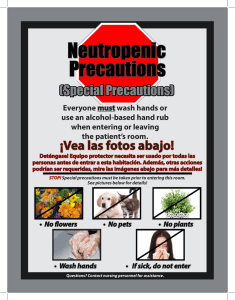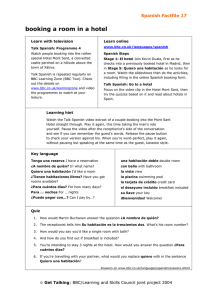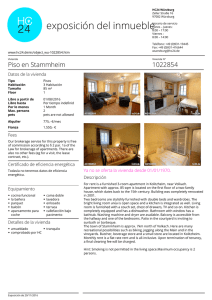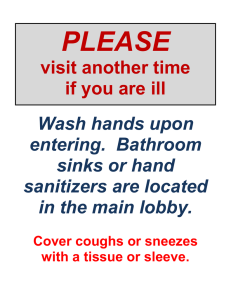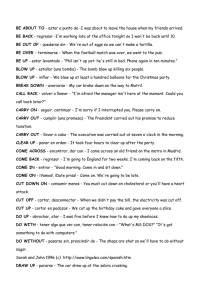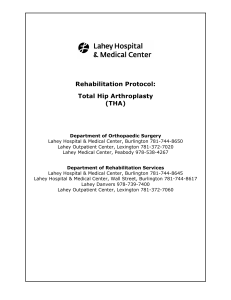Isolation Sign Changes
Anuncio
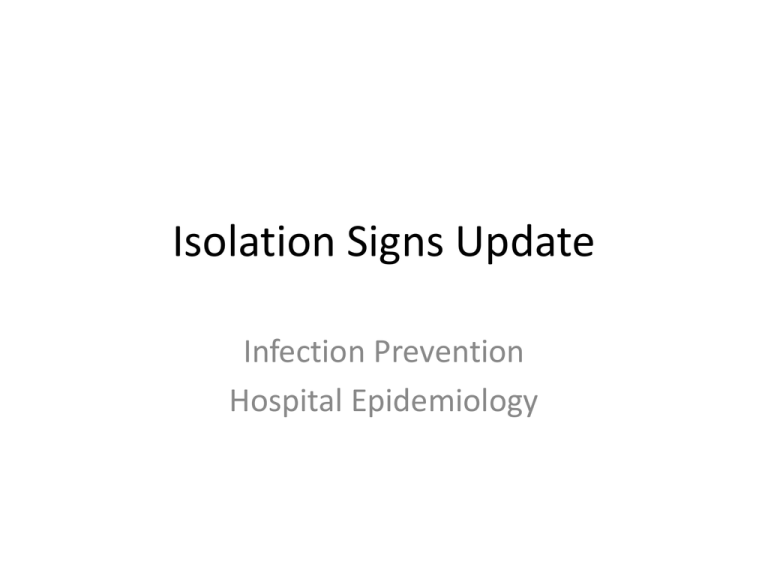
Isolation Signs Update Infection Prevention Hospital Epidemiology Airborne Precautions • • • Negative pressure room required Doors must remain closed Patients can go to medically necessary tests/procedures • • Procedure area must obtain 2 HEPA filters from patient equipment and place one at head of bed and one at door to room HEPA filter must remain on for 30 minutes after patient has left and no other patient may enter area for those 30 minutes AIRBORNE PRECAUTIONS PRECAUCIONES DE TRANSMISIÓN AÉREA Perform hand hygiene Llevar a cabo la higiene de las manos. Respirator (N95) when entering room Utilizar respirador (N95) al entrar a la habitación. When to Use • Keep door closed Suspected or confirmed TB Mantener la puerta cerrada. HCP • Wear N-95 respirator Families and Guests Familias y visitantes Families and Guests Report to nurses station before entering room Presentarse en la estación de enfermeras antes de entrar a la • • Clean hands upon entering and exiting room Lavarse las manos al entrar y al salir de la habitación. Wear a surgical mask and remove after exiting room Utilizar mascarilla quirúrgica y quitársela después de salir de la • Wear a surgical mask while in room For pediatric patients parents/primary care givers must be ruled out for active pulmonary TB Contact Hospital Epidemiology for assistance in ruling out family members/primary care givers of pediatric patients habitación. habitación. Translated by UNC Health Care Interpreter Services, 04/14/15 Airborne- Contact Precautions • New sign When to Use • Patients with shingles on 3 or more dermatomes or immunocompromised patients with shingles on 1 or more dermatome • Suspected or confirmed chicken pox HCP • Wear N-95 respirator AND gowns and gloves • Remove N-95 after departing room Families and Guests • Wear surgical mask, gowns and gloves AIRBORNE-CONTACT PRECAUTIONS PRECAUCIONES DE TRANSMISIÓN AÉREA Y POR CONTACTO Perform hand hygiene Llevar a cabo la higiene de manos. Respirator (N95) when entering room Utilizar respirador (N95) al entrar a la habitación. Keep door closed Mantener la puerta cerrada. Gown when entering room Utilizar bata al entrar a la habitación. Gloves when entering room Utilizar guantes al entrar a la habitación. Families and Guests Familias y visitantes Report to nurses station before entering room Presentarse en la estación de enfermeras antes de entrar a la habitación. Clean hands upon entering and exiting room Lavarse las manos al entrar y al salir de la habitación. Wear a surgical mask, gown, and gloves and remove upon exiting room Utilizar mascarilla quirúrgica, bata y guantes y quitárselos al salir de la habitación. Translated by UNC Health Care Interpreter Services, 04/14/15 Droplet-Contact Precautions • New Sign • Patients must be placed in a private room When to Use • For patients with certain respiratory viruses (e.g. RSV) • Empirically isolate with DropletContact when a respiratory virus is suspected and while a Respiratory Viral Panel (RVP) is pending HCP • Wear a surgical mask, gown and gloves Families and Guests • Wear surgical mask, gown and gloves the entire time they are in the room DROPLET-CONTACT PRECAUTIONS PRECAUCIONES DE TRANSMISIÓN POR GOTAS Y POR CONTACTO Perform hand hygiene Llevar a cabo la higiene de manos. Surgical mask while in room Utilizar mascarilla quirúrgica en la habitación. Gown when entering room Utilizar bata al entrar a la habitación. Gloves when entering room Utilizar guantes al entrar a la habitación. Families and Guests Familia y visitantes Clean hands upon entering and exiting room Lavarse las manos al entrar y al salir de la habitación. Wear a surgical mask, gown, and gloves and remove before exiting room Utilizar mascarilla quirúrgica, bata y guantes y quitárselos antes de salir de la habitación. Translated by UNC Health Care Interpreter Services, 04/14/15 RVP Results – Now what? Appendix 3: Quick Glance for Respiratory Virus Panel Isolation Precautions Resp Virus NAA Precautions Type Duration Comments Influenza A Influenza B Adults 7 days adults D • IC 0031: Isolation Precautions policy Appendix 3: Quick Glance for Respiratory Virus Panel Isolation Precautions • See which respiratory virus the patient has and follow the guidance for the type of isolation • Order the appropriate isolation When can my patient come off of isolation for their respiratory virus? • Reference Quick Glance Guide • Each respiratory virus has different evidence-based guidance for discontinuing precautions More questions? Call Infection Control 984-974-7500 Pediatric and immunocompromised persons of all ages Adenovirus 10 days Droplet Precautions. Single patient room when available or cohort; avoid placement with high-risk patients; mask patient when transported out of room. Gloves and gown may be necessary in pediatric settings if contamination with respiratory secretions is possible. Precautions should remain in effect until the patient is asymptomatic and has 1 negative NP adenovirus test. D, C Wear masks according to Standard Precautions. Metapneumovirus Adult Pediatric and BMT Unit patients (Contact isolation is not required for BMT patients outside of the BMT Unit) S C DI Viral shedding may be prolonged in immunosuppressed patients. Reliability of antigen testing to determine when to remove patients with prolonged hospitalizations from Contact Precautions uncertain. Parainfluenza 1 Parainfluenza 2 Parainfluenza 3 Parainfluenza 4 Adults Pediatric and BMT Unit patients (Contact isolation is not required for BMT patients outside of the BMT Unit) RSV Rhinovirus Adults Pediatric and BMT Unit patients (Droplet and Contact isolation is not required for BMT patients outside of the BMT Unit) Coronavirus (not SARS) Adults S C DI Precautions should remain in effect until the patient is asymptomatic for 1 week or 14 days from the onset of illness and has 1 negative NP RSV test. High –risk areas such as PICU may elect to continue isolation precautions until 2 negative NP RSV tests are obtained. D, C S D, C D, C DI DI Infants/Children D, C When a Respiratory Viral Panel is sent the patient should be placed on Droplet plus Contact Precautions until test finalized and then follow precautions as listed above. DI = Duration of Illness (until symptoms have resolved) D = droplet precautions. C = contact precautions. S = standard precautions. Droplet Precautions • Patients must be placed in a private room When to Use • Patients with certain respiratory viruses (e.g. flu) • Confirmed or suspected meningococcal meningitis • Parvovirus B-19 HCP • Wear a surgical mask Families and Guests • Wear surgical mask the entire time they are in the room DROPLET PRECAUTIONS PRECAUCIONES DE TRANSMISIÓN POR GOTAS Perform hand hygiene Llevar a cabo la higiene de manos. Surgical mask while in room Utilizar mascarilla quirúrgica en la habitación. Families and Guests Familias y visitantes Clean hands upon entering and exiting room Lavarse las manos al entrar y al salir de la habitación. Wear a surgical mask while in the room and remove upon exiting. Utilizar mascarilla quirúrgica en la habitación y quitársela al salir. Translated by UNC Health Care Interpreter Services, 04/14/15 New Infection Field in EPIC Parvovirus B19 is a droplet spread virus. Complications of parvovirus B19 infection include: Complications of Pregnancy Chronic Arthralgia There is a new Infection Field in EPIC for Parvovirus B19. Patients flagged for Parvovirus B19 require Droplet Precautions. Wear a standard surgical mask when caring for patients with Parvovirus B19. Patients who are immunocompromised and PCR positive for Parvovirus B19 will be flagged in EPIC. If you suspect your patient needs to be flagged for Parvovirus B19, please contact Hospital Epidemiology. Questions? Call Hospital Epidemiology 984-974-7500 Contact Precautions • Patients must be placed in a private room • Required if patient is flagged in infection field • Speak to Infection Control before removing Contact Precautions so patient can be unflagged. When to Use • Patients with multi-drug resistant organisms (MDRO) (e.g. MRSA/ORSA, VRE) • All patients with Cystic Fibrosis HCP • Wear gown and gloves Families and Guests • Do not require gowns or gloves • Educate family about the importance of hand hygiene CONTACT PRECAUTIONS PRECAUCIONES DE TRANSMISIÓN POR CONTACTO Perform hand hygiene Llevar a cabo la higiene de las manos. Gloves when entering room Utilizar guantes al entrar al cuarto. Gown for direct patient care or whenever clothing may contact surfaces in the room Uso de bata cuando se entre en contacto directo con el paciente o cuando la ropa pueda entrar en contacto con las superficies en la habitación. Families and guests: Familias y visitantes Clean hands upon entering and exiting room Lavarse las manos al entrar y al salir de la habitación. Do not need to wear gowns or gloves No es necesario el uso de batas ni de guantes. Translated by UNC Health Care Interpreter Services, 04/14/15 Enteric Precautions • • • Patients must be placed in a private room Clean room and equipment with bleach Leave sign on door after patient discharges so EVS knows to terminal clean with bleach When to Use • Suspected or confirmed Clostridium difficile • Empirically isolate patients while waiting for C. difficile test result • Gastroenteritis (e.g. norovirus, rotavirus or adenovirus) HCP • Wear gown and gloves and perform hand hygiene with soap and water upon exiting room Families and Guests • Wear gown and gloves and perform hand hygiene with soap and water upon exiting room ENTERIC CONTACT PRECAUTIONS ENTERIC PRECAUTIONS PRECAUCIONES DE TRANSMISIÓN ENTÉRICA Perform hand hygiene before entering room or cubicle and wash hands with SOAP AND WATER for 15 seconds before leaving the room. Llevar a cabo la higiene de las manos antes de entrar a la habitación o al cubículo y lavarse las manos con jabón y agua por 15 segundos antes de salir de la habitación. Gloves when entering the room Utilizar guantes al entrar a la habitación. Gown for direct patient care or whenever clothing may contact surfaces or equipment in the room Uso de bata cuando se entre en contacto directo con el paciente o cuando la ropa vaya a estar en contacto con las superficies en el cuarto. Families and Guests Familias y visitantes Clean hands upon entering and wash hands with soap and water upon exiting room Lavarse las manos al entrar y lavarse las manos con jabón y agua al salir de la habitación. Wear a gown and gloves while in the room and remove before exiting room Utilizar bata y guantes en la habitación y quitárselos antes de salir de la habitación. Translated by UNC Health Care Interpreter Services, 04/14/15

